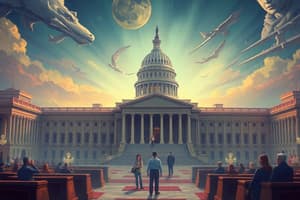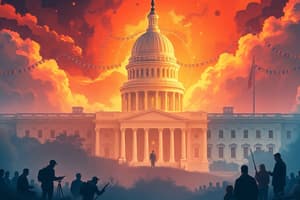Podcast
Questions and Answers
Which term describes the process by which states are allocated congressional seats based on population?
Which term describes the process by which states are allocated congressional seats based on population?
- Apportionment (correct)
- Gerrymandering
- Redistricting
- Bicameralism
Who ranks second in authority within the House of Representatives?
Who ranks second in authority within the House of Representatives?
- The Minority Leader
- The Speaker of the House
- The Majority Leader (correct)
- The Whip
What is the primary function of whips in Congress?
What is the primary function of whips in Congress?
- To represent the president's interests
- To draft new legislation
- To lead committee meetings
- To count votes and ensure party discipline (correct)
What process is required to formally end a filibuster in the Senate?
What process is required to formally end a filibuster in the Senate?
What happens to a bill that has been pocket vetoed?
What happens to a bill that has been pocket vetoed?
Why were presidents Andrew Johnson and Bill Clinton impeached but not removed from office?
Why were presidents Andrew Johnson and Bill Clinton impeached but not removed from office?
What role does the Congressional Research Service fulfill?
What role does the Congressional Research Service fulfill?
What is a select or special committee in Congress?
What is a select or special committee in Congress?
What role does the vice president serve in the Senate?
What role does the vice president serve in the Senate?
What is the purpose of a discharge petition in the House of Representatives?
What is the purpose of a discharge petition in the House of Representatives?
What procedure in the Senate limits debate on budget controversies to twenty hours?
What procedure in the Senate limits debate on budget controversies to twenty hours?
How does logrolling function in Congress?
How does logrolling function in Congress?
Which of the following steps is NOT part of the typical path a bill takes in the House of Representatives?
Which of the following steps is NOT part of the typical path a bill takes in the House of Representatives?
If a senator wants to express objections to a bill and wishes to be consulted further, what tactic should they use?
If a senator wants to express objections to a bill and wishes to be consulted further, what tactic should they use?
What is a good example of constituent casework?
What is a good example of constituent casework?
What does the trustee model of representation entail?
What does the trustee model of representation entail?
Flashcards
Apportionment
Apportionment
Distributing congressional seats based on a state's population.
Bicameral Legislature
Bicameral Legislature
A legislature with two chambers (e.g., Senate and House of Representatives).
Majority Leader (House)
Majority Leader (House)
Second in authority to the Speaker of the House.
Conference Committee
Conference Committee
Signup and view all the flashcards
Delegate (voting)
Delegate (voting)
Signup and view all the flashcards
Cloture
Cloture
Signup and view all the flashcards
Appropriations Process
Appropriations Process
Signup and view all the flashcards
Party Caucus
Party Caucus
Signup and view all the flashcards
Trustee Model
Trustee Model
Signup and view all the flashcards
Discharge Petition
Discharge Petition
Signup and view all the flashcards
Reconciliation
Reconciliation
Signup and view all the flashcards
Logrolling
Logrolling
Signup and view all the flashcards
Constituent Casework
Constituent Casework
Signup and view all the flashcards
Hold
Hold
Signup and view all the flashcards
What is the typical path a bill follows through the House?
What is the typical path a bill follows through the House?
Signup and view all the flashcards
What is the typical path a bill follows through the Senate?
What is the typical path a bill follows through the Senate?
Signup and view all the flashcards
Study Notes
Congressional Structure and Function
- Apportionment: States are awarded congressional seats based on population proportion.
- Legislature: A bicameral legislature (Senate and House of Representatives) was created by the Constitutional Convention.
- House Leadership: The Majority Leader is second in authority to the Speaker of the House.
- Conference Committees: These committees reconcile differences in bills passed by the House and Senate.
- Pork-Barrelling: Directing federal funds or benefits to a specific district can aid a member of Congress's district.
- Delegate Model: An elected official who votes as their constituents want.
- Whips: Count votes and ensure party discipline.
- Filibuster Cloture: Cloture, requiring 60 votes, formally ends a filibuster.
- Pocket Veto: A bill can become law if pocket vetoed, but only if the president doesn't sign it and Congress adjourns.
- House Apportionment: Members of the House are apportioned based on population and serve two-year terms.
- Congressional Research Service (CRS): Provides nonpartisan summaries of bills and tracks their progress.
- Impeachment: Andrew Johnson and Bill Clinton were impeached but not removed from office due to failures in the Senate trial after the House vote.
- House Size: The House of Representatives has 435 members, a fixed number by law.
- Appropriations: Congress grants federal funds to agencies and programs during the appropriations process.
- Party Unity: Congressional party unity measures partisan cohesion and discipline.
Congressional Procedures and Processes
- Party Caucus: Members of Congress gather to select leadership.
- Select/Special Committees: Temporary committees appointed for specific purposes.
- Congressional Approval: Americans' approval ratings of Congress fluctuate with effectiveness and partisan gridlock.
- Senate Presiding Officer: The Vice President presides over the Senate.
- President Pro Tempore: Selected by the majority party to preside over the Senate in the VP's absence.
- House Majority Leader: Smooths passage of majority-backed bills.
- Trustee Model: Legislators use judgment and expertise to make decisions.
- Discharge Petition: A way to force a bill out of committee and onto the House floor.
- Bill Process (House): Bills typically follow a path of introduction, committee referral, subcommittee review, full committee report and floor debate, conference committee, and presidential action.
- Bill Process (Senate): Similar path of introduction, referral, subcommittee, committee, debate, conference committee and presidential action.
- Casework: Assisting constituents in obtaining government services.
- Staff Influence: Members' staff influence how representatives vote on bills impacting their district.
- Reconciliation: Limits debate on budget controversies to twenty hours, ending potential filibusters.
- Logrolling: When members agree to support each other's bills in exchange for support.
- HOLD: A tactic a senator uses to signal objections to a bill or nomination, requiring consultation before further action.
Studying That Suits You
Use AI to generate personalized quizzes and flashcards to suit your learning preferences.




